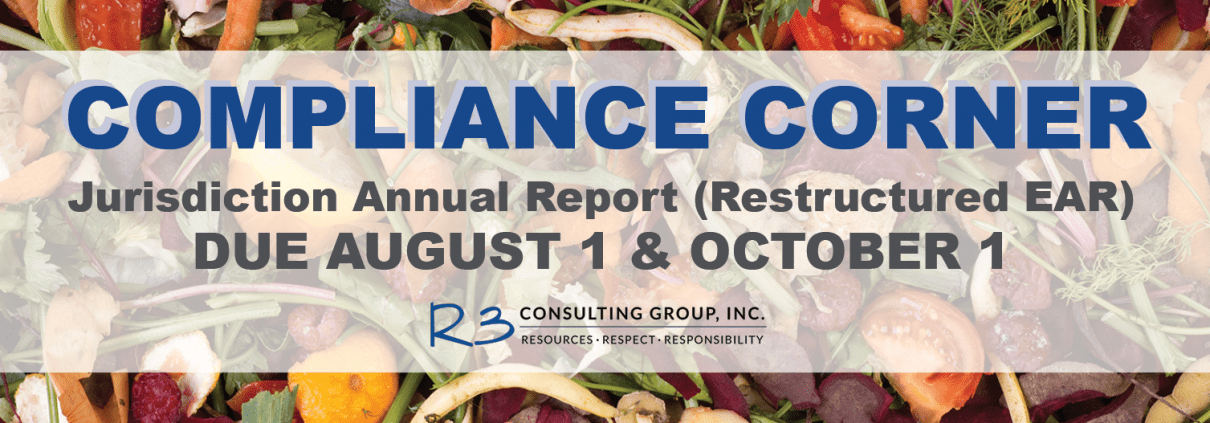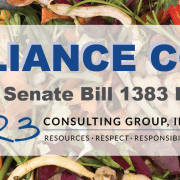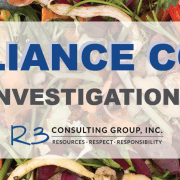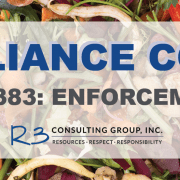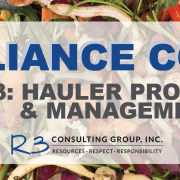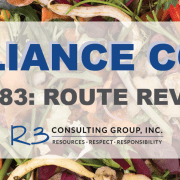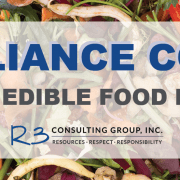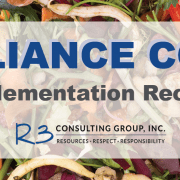Compliance Corner – March 2022 (2 of 3)
Are you ready for the Inspection and Recordkeeping requirements of SB 1383? Have you started the report for your jurisdiction due on April 1, 2022? And how is it different from the reports due August 1, 2022 and October 1, 2022? R3 is ready to help you get up to speed with inspections, recordkeeping, and reporting!
See below for the Jurisdiction Annual Reporting due August 1, 2022 and October 1, 2022 (and August 1 annually thereafter); see here for more information regarding the Initial Jurisdiction Compliance Report due by Friday, April 1, 2022; and see here for the Implementation Record and Inspection Requirements. Please don’t hesitate to reach out to the R3 team if you need further assistance!
March 2022 – Inspections and Recordkeeping
For this month, we’re looking at SB 1383 Inspections, Recordkeeping, and Reporting requirements, primarily focusing on three parts:
- Initial Jurisdiction Compliance Report
- Jurisdiction Annual Report (Restructured EAR)
- Implementation Record and Inspection Requirements
See below for some tips and guidelines that will help you through this ongoing process. Please remember to start tracking information in your Implementation Record now!
2. Jurisdiction Annual Report (Restructured EAR)
Each jurisdiction is required to submit an annual report on August 1 annually. In 2022, each jurisdiction will also be required to submit a report on its compliance with the requirements of SB 1383 by October 1, 2022 covering information from January 1, 2022 through June 30, 2022. Then, by August 1, 2023 ,and annually thereafter on August 1, submittal of the EAR will be required. The annual reports Due on August 1 will cover the previous calendar year.
The annual report must include the following information as it relates to the implementation of the following:
- Organic Waste Collection
- Type of collection services provided to generators
- Number of generators that receive each type of service
- If applicable, RDRS number of high diversion organic waste processing facilities
- If applicable, facility that accepts compostable plastics
- If applicable, facility that accepts and removes organic waste in plastic bags
- Contamination Monitoring
- Number of route reviews
- Number of times notices, violations, or targeted educational materials were issued to generators
- Results of waste evaluations performed and number of resulting target route reviews
- Waivers
- Number of days emergency circumstances waiver was in effect and type of waiver issued
- Tons of organic waste disposed as a result of emergency waivers
- Number of generators issued a de minimis waiver
- Number of generators issued a physical space waiver
- Jurisdictions that receive a waiver from CalRecycle shall report, for each year the waiver is in effect, the number of generators waived from the requirement to subscribe to organic waste collection service
- Education and Outreach
- Number of organic waste generators and edible food generators that received information and the type of education and outreach used
- Hauler Oversight
- Number of haulers approved to collect organic waste in the jurisdiction
- RDRS number of each facility receiving organic waste from approved haulers in the jurisdiction
- Number of haulers that have had their approval revoked or denied
- Edible Food Recovery
- Number of commercial edible food generators within the jurisdiction
- Number of food recover services and organizations located and operating within the jurisdiction, that contract with or have written agreements with commercial food generators
- Total pounds of edible food recovered in the previous calendar year (services/organizations must report amount to the jurisdiction)
- Procurement
- Amount of each recovered organic waste product (ROWP) procured directly by the city, county, or through direct service providers (or both) during the previous calendar year
- If implementing procurement requirements through an adjusted ROWP procurement target, report the total amount of transportation fuel, electricity, and gas for heating applications procured during the previous calendar year
- CALGreen Building Standards and Model Water Efficient Landscape Ordinance
- Number of C&D debris removal activities conducted
- Compliance
- Number of commercial businesses included in a compliance review as well as the number of violations found and corrected through compliance reviews
- Compliance with waste generator requirements and self-haul requirements, including whether a business is complying through back-hauling organic waste
- Monitoring
- Number of route reviews conducted (or waste evaluations performed) annually for commercial businesses and residential generators
- Number of inspections conducted by type for commercial edible food generators, food recovery organizations, and commercial businesses
- Enforcement requirements
- Number of complaints that were received and investigated, and number of Notices of Violations (NOVs) issued based on investigation of complaints
- Number of NOVs issued, categorized by type of entity
- Number of penalty orders issued, categorized by type of entity
- Number of enforcement actions resolved, categorized by type of entity
In addition, Counties shall report the following regarding implementation of organic waste recycling capacity planning and edible food recovery planning:
- Tons estimated to be generated for landfill disposal
- Amount of capacity verifiably available to the county and cities
- Amount of new capacity needed
- Locations identified for new or expanded facilities
- Jurisdictions that are required to submit implementation schedules
- Jurisdictions that did not provide information required to the county within 120 days

